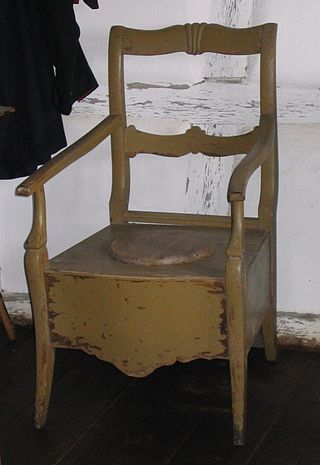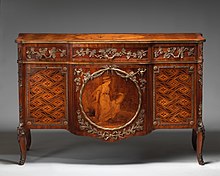
A closet is an enclosed space, with a door, used for storage, particularly that of clothes. Fitted closets are built into the walls of the house so that they take up no apparent space in the room. Closets are often built under stairs, thereby using awkward space that would otherwise go unused.

A secretary desk or escritoire is made of a base of wide drawers topped by a desk with a hinged desktop surface, which is in turn topped by a bookcase usually closed with a pair of doors, often made of glass. The whole is usually a single, tall and heavy piece of furniture.

Jean-Henri Riesener was a famous German ébéniste (cabinetmaker), working in Paris, whose work exemplified the early neoclassical "Louis XVI style".

A Carlton House desk is a specific antique desk form within the more general bureau à gradin form. This form of desk is supposed to have been designed in the 18th century for the Prince of Wales by George Hepplewhite. It is named after Carlton House, which was at the time the London residence of the Prince, and sometimes is also known as a Carlton House writing table.

The Wallace Collection is a museum in London occupying Hertford House in Manchester Square, the former townhouse of the Seymour family, Marquesses of Hertford. It is named after Sir Richard Wallace, who built the extensive collection, along with the Marquesses of Hertford, in the 18th and 19th centuries. The collection features fine and decorative arts from the 15th to the 19th centuries with important holdings of French 18th-century paintings, furniture, arms and armour, porcelain and Old Master paintings arranged into 25 galleries. It is open to the public and entry is free.

A chest of drawers, also called a dresser or a bureau, is a type of cabinet that has multiple parallel, horizontal drawers generally stacked one above another.

A lowboy is an American collectors term for one type of dressing table. It is a small table with one or two rows of drawers, so called in contradistinction to the tallboy or highboy chest of drawers.

A washstand or basin stand is a piece of furniture consisting of a small table or cabinet, usually supported on three or four legs, and most commonly made of mahogany, walnut, or rosewood, and made for holding a wash basin and water pitcher. The smaller varieties were used for rose-water ablutions, or for hair-powdering. The larger ones, which possessed receptacles for soap dishes, were the predecessors of the modern bathroom wash basin, or sink. Both varieties, often of very elegant form, were in extensive use throughout a large part of the 18th century and early-19th century, eventually disappearing with the advent of modern indoor plumbing.
Campaign furniture is a type of furniture which is made for travel. Historically, much of it was made for military campaigns.

The term chiffonier, also chiffonnier, may refer to one of at least two types of furniture. Its name comes directly from a French piece of furniture, the chiffonier. The French name, which comes from the French for a rag-picker, suggests that it was originally intended as a receptacle for odds and ends which had no place elsewhere.

Ince and Mayhew were a partnership of furniture designers, upholsterers and cabinetmakers, founded and run by William Ince (1737–1804) and John Mayhew (1736–1811) in London, from 1759 to 1803; Mayhew continued alone in business until 1809. Their premises were located in Marshall Street but were listed in London directories in Broad Street, Soho, 1763–83, and in Marshall Street, Carnaby Market, 1783–1809. The partnership's volume of engraved designs, The Universal System of Household Furniture, dedicated to the Duke of Marlborough, was issued in imitative rivalry with Thomas Chippendale; Ince, who was a subscriber to the first edition of Chippendale's Director, was chiefly responsible for the designs, while Mayhew contributed the greater part of the partnership's capital, kept the accounts, and was in closer contact with the firm's clientele among the nobility and gentry. The name of the firm originally appears to have been "Mayhew and Ince", but on the title page of The Universal System the names are reversed, suggesting that Ince was the more extensive contributor.

A close stool was an early type of portable toilet, made in the shape of a cabinet or box at sitting height with an opening in the top. The external structure contained a pewter or earthenware chamberpot to receive the user's excrement and urine when they sat on it; this was normally covered (closed) by a folding lid. "Stool" has two relevant meanings: as a type of seat and as human feces. Close stools were used from the Middle Ages until the introduction of the indoor flush toilet.
Benjamin Goodison, of London, was a royal cabinetmaker to George II of Great Britain, supplying furnishings to the royal palaces from 1727 to the time of his death. He served his apprenticeship with James Moore, who died accidentally in October 1726; Moore was the pre-eminent London cabinetmaker during the reign of George I. Goodison's classicizing case furniture owes much of its inspiration to the neo-Palladian designs of William Kent; outstanding documented examples are the pair of part-gilded mahogany commodes and library writing-tables Goodison made for Sir Thomas Robinson of Rokeby Hall, Yorkshire, now in the Royal Collection; they have boldly-scaled Greek key fret in their friezes and lion masks gripping brass rings heading scrolling consoles at their corners.
Italian Baroque interior design refers to high-style furnishing and interior decorating carried out in Italy during the Baroque period, which lasted from the early 17th to the mid-18th century. In provincial areas, Baroque forms such as the clothes-press or armadio continued to be used into the 19th century.

Mathieu Criaerd (1689–1776) was the most prominent of a large family of cabinetmakers (ébénistes), apparently of Flemish ancestry, who were working in Paris during the 18th century. He became a master in the Corporation des Menuisiers-Ébénistes 29 July 1738 and set up his workshop in the rue Traversière-Saint-Antoine, in the heart of the furniture-making district of Paris, using the stamp M CRIAERD.

The furniture of the Louis XV period (1715–1774) is characterized by curved forms, lightness, comfort and asymmetry; it replaced the more formal, boxlike and massive furniture of the Louis XIV style. It employed marquetry, using inlays of exotic woods of different colors, as well as ivory and mother of pearl.

The furniture of Louis XIV was massive and lavishly covered with sculpture and ornament of gilded bronze in the earlier part of the personal rule of King Louis XIV of France (1660–1690). After about 1690, thanks in large part to the furniture designer André Charles Boulle, a more original and delicate style appeared, sometimes known as Boulle work. It was based on the use of marquetry, the inlay of pieces of ebony and other rare woods, a technique first used in Florence in the 15th century, which was refined and developed by Boulle and others working for the King. Furniture was inlaid with thin plaques of ebony, copper, mother of pearl, and exotic woods of different colors in elaborate designs.

Louis XVI furniture is characterized by elegance and neoclassicism, a return to ancient Greek and Roman models. Much of it was designed and made for Queen Marie Antoinette for the new apartments she created in the Palace of Versailles, Palace of Fontainebleau, the Tuileries Palace, and other royal residences. The finest craftsmen of the time, including Jean-Henri Riesener, Georges Jacob, Martin Carlin, and Jean-François Leleu, were engaged to design and make her furniture.

The dressing table is a table specifically designed for performing one's toilette, intended for a bedroom or a boudoir.





















